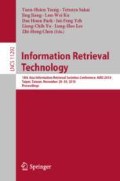Abstract
Named entity recognition (NER) is a fundamental task in natural language processing and there is a lot of interest on vertical NER such as medical NER, short text NER etc. In this paper, we study the problem of Chinese governmental NER (CGNER). CGNER serves as the basis for automatic governmental text analysis, which can greatly benefit the public. Considering the characteristics of the governmental text, we first formulate the task of CGNER, adding one new entity type, i.e., policy (POL) in addition to the generic types such as person (PER), location (LOC), organization (ORG) and title (TIT) for recognition. Then we constructed a dataset called GOV for CGNER. We empirically evaluate the performances of mainstream NER tools and state-of-the-art BiLSTM-CRF method on the GOV dataset. It was found that there is a performance decline compared to applying these methods on generic NER dataset. Further studies show that compound entities account for a non-negligible proportion and using the classical BIO (Begin-Inside-Outside) annotation cannot encode the entity type combination effectively. To alleviate the problem, we propose to utilize the compound tagging and BiLSTM-CRF for doing CGNER. Experiments show that our proposed methods can significantly improve the CGNER performance, especially for the LOC, ORG and TIT entity types.
Access this chapter
Tax calculation will be finalised at checkout
Purchases are for personal use only
References
Grishman, R., Sundheim, B.: Message understanding conference-6: a brief history. In: COLING 1996 Volume 1: The 16th International Conference on Computational Linguistics, vol. 1 (1996)
Uzuner, Ö., South, B.R., Shen, S., DuVall, S.L.: 2010 i2b2/va challenge on concepts, assertions, and relations in clinical text. J. Am. Med. Inf. Assoc. 18(5), 552–556 (2011)
Sekine, S.: Description of the Japanese ne system used for met-2. In: Seventh Message Understanding Conference (MUC-7): Proceedings of a Conference Held in Fairfax, Virginia, 29 April–1 May 1998 (1998)
Asahara, M., Matsumoto, Y.: Japanese named entity extraction with redundant morphological analysis. In: Proceedings of the 2003 Conference of the North American Chapter of the Association for Computational Linguistics on Human Language Technology, vol. 1, pp. 8–15. Association for Computational Linguistics (2003)
Borthwick, A., Sterling, J., Agichtein, E., Grishman, R.: Description of the MENE named entity system as used in MUC-7. In: Proceedings of the Seventh Message Understanding Conference (MUC-7), Fairfax, Virginia, 29 April–1 May 1998 (1998)
Bikel, D. M., Miller, S., Schwartz, R., Weischedel, R.: Nymble: a high-performance learning name-finder. In: Proceedings of the fifth conference on Applied natural language processing, pp. 194–201. Association for Computational Linguistics (1997)
McCallum, A., Li, W.: Early results for named entity recognition with conditional random fields, feature induction and web-enhanced lexicons. In: Proceedings of the seventh conference on Natural language learning at HLT-NAACL 2003, vol. 4, pp. 188–191. Association for Computational Linguistics (2003)
Yao, Y., Sun, A.: Mobile phone name extraction from internet forums: a semi-supervised approach. World Wide Web 19(5), 783–805 (2016)
Collobert, R., Weston, J., Bottou, L., Karlen, M., Kavukcuoglu, K., Kuksa, P.: Natural language processing (almost) from scratch. J. Mach. Learn. Res. 12(Aug), 2493–2537 (2011)
Huang, Z., Xu, W., Yu, K.: Bidirectional LSTM-CRF models for sequence tagging. arXiv preprint arXiv:1508.01991 (2015)
Chiu, J.P., Nichols, E.: Named entity recognition with bidirectional LSTM-CNNs. arXiv preprint arXiv:1511.08308 (2015)
Ma, X., Hovy, E.: End-to-end sequence labeling via bi-directional LSTM-CNNs-CRF. arXiv preprint arXiv:1603.01354 (2016)
Lample, G., Ballesteros, M., Subramanian, S., Kawakami, K., Dyer, C.: Neural architectures for named entity recognition. arXiv preprint arXiv:1603.01360 (2016)
Dong, C., Zhang, J., Zong, C., Hattori, M., Di, H.: Character-based LSTM-CRF with radical-level features for chinese named entity recognition. In: Lin, C.-Y., Xue, N., Zhao, D., Huang, X., Feng, Y. (eds.) ICCPOL/NLPCC -2016. LNCS (LNAI), vol. 10102, pp. 239–250. Springer, Cham (2016). https://doi.org/10.1007/978-3-319-50496-4_20
Dernoncourt, F., Lee, J.Y., Szolovits, P.: Neuroner: an easy-to-use program for named-entity recognition based on neural networks. arXiv preprint arXiv:1705.05487 (2017)
Fu, C., Fu, G.: Morpheme-based chinese nested named entity recognition. In: 2011 Eighth International Conference on Fuzzy Systems and Knowledge Discovery (FSKD), vol. 2, pp. 1221–1225. IEEE (2011)
Levow, G.-A.: The third international chinese language processing bakeoff: word segmentation and named entity recognition. In: Proceedings of the Fifth SIGHAN Workshop on Chinese Language Processing, pp. 108–117 (2006)
Kingma, D.P., Ba, J.: Adam: a method for stochastic optimization. arXiv preprint arXiv:1412.6980 (2014)
Zheng, S., Wang, F., Bao, H., Hao, Y., Zhou, P., Xu, B.: Joint extraction of entities and relations based on a novel tagging scheme. arXiv preprint arXiv:1706.05075 (2017)
Acknowledgment
We would like to thank the anonymous reviewers for their insightful comments and suggestions. This research is supported by the The National Key Research and Development Program of China (grant No. 2016YFB0801003 & 2017YFB0803301).
Author information
Authors and Affiliations
Corresponding author
Editor information
Editors and Affiliations
Rights and permissions
Copyright information
© 2018 Springer Nature Switzerland AG
About this paper
Cite this paper
Liu, Q., Wang, D., Zhou, M., Li, P., Qi, B., Wang, B. (2018). Chinese Governmental Named Entity Recognition. In: Tseng, YH., et al. Information Retrieval Technology. AIRS 2018. Lecture Notes in Computer Science(), vol 11292. Springer, Cham. https://doi.org/10.1007/978-3-030-03520-4_2
Download citation
DOI: https://doi.org/10.1007/978-3-030-03520-4_2
Published:
Publisher Name: Springer, Cham
Print ISBN: 978-3-030-03519-8
Online ISBN: 978-3-030-03520-4
eBook Packages: Computer ScienceComputer Science (R0)

